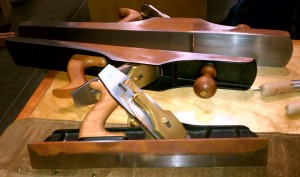With my recent lower back surgeries, I’ve had a decent period of time where I was completely unable to do any woodworking, and while this hopefully doesn’t directly relate to any reader, many will likely have (past or present) life get in the way of our enjoyable pastime.
I thought I’d share some of my thoughts about getting back into the shop. As we all know, with the passing of time, some not so nice things can occur in your shop. Specifically, since many of your tools are probably made from steel or iron, there is a somewhat high probability that Mr. Rust Demon just might have paid you a visit. I know, we all try to do what we can to protect our precious tools, but this is a beast that never rests.
 When I was finally able to get into my shop, the first thing I did was to give my planes a once-over, just to make sure no rust had started to take hold. It is pretty amazing just how fast rust can get a foothold, and even with some of the best preventatives, if some dust can accumulate, there is a great likelihood rust will soon follow. For those that don’t already know, dust seems to absorb moisture directly from the air, and then holds the moisture in close proximity to the metal. Not a good situation.
When I was finally able to get into my shop, the first thing I did was to give my planes a once-over, just to make sure no rust had started to take hold. It is pretty amazing just how fast rust can get a foothold, and even with some of the best preventatives, if some dust can accumulate, there is a great likelihood rust will soon follow. For those that don’t already know, dust seems to absorb moisture directly from the air, and then holds the moisture in close proximity to the metal. Not a good situation.
So, while looking for any potential rust, I was also making sure to remove any dust that was present. I was lucky this time and there were no signs of rust on any of my tools, but there have been times I was not so lucky. We’ve had a very dry period where I live, and this just may have been what saved my tools.
If I find rust, I eradicate it as quickly as possible, since once a tool has rust, it will only spread. The location of the rust dictates how much precision is required during the removal process. For example, if the rust is on the top surface of a plane iron, towards the rear, I can use some fine grit sandpaper, a sanding sponge, a Scotch Brite, or just about anything. This is because nothing references off of this surface, nor will it ever come in contact with any wood. If, on the other hand, I find some rust on the sole of a plane, I would use either some fine-grit sandpaper or a Scotch Brite, making sure to have a perfectly flat granite block, piece of plate glass, or a wing on a table saw or powered jointer as my reference surface. This would allow me to again remove any rust, but also retain the necessary flat nature of the sole. As one additional note, even though I would be working on a known flat surface, I would still need to work slowly and make sure I applied pressure only towards the center of the plane’s sole. It is interesting how something as simple as a little pressure, if it isn’t directed where you need it, will cause quicker removal of material at that location compared to other areas. This is the same concept as when we apply a slight camber to a plane iron, simply by applying additional pressure and strokes to one corner, even though the iron looks to stay in contact across its width.
Another thing I find useful if I haven’t been able to work with my tools in a while, is a re-sharpening. Even though a sharp tool polished with a higher-grit stone will be slow to deteriorate, I’ve found tools that I know I put away razor sharp acting almost like I’d already used them for awhile. Now I’m not talking about going crazy and bringing the full bevel back to 25-degrees and sharpening from there. Just a basic “touch-up”, if you will, so that freshly sharpened behavior is back.
Lastly, if it has been a really long time since you’ve touched a tool, start with an off cut that doesn’t mean anything to you. Basically just get your feel back, since using tools is similar to playing an instrument, and even the best musician will warm up before a recital, even if they play regularly.
I hope these tips will help everyone to enjoy themselves as they get back in the shop.
Lee Laird has enjoyed woodworking for over 20 years. He is retired from the U.S.P.S. and works for Lie-Nielsen Toolworks as a show staff member, demonstrating tools and training customers. You can email him at lee@lie-nielsen.com or follow him on Twitter at twitter.com/is9582


Thank you for the information. You’ve gained a new subscriber.